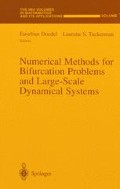Abstract
Mathematical models of chemical reactors are known to exhibit very complex bifurcation behavior due to the strong coupling between the transport processes and the nonlinear dependence of the reaction rates on temperature and concentration. During the past fifty years, they have proved to be an inexhaustible source for the development and testing of various local bifurcation techniques. Unlike the Navier-Stokes equations, which are partial differential equations in time and two/three spatial coordinates, models of chemical reactors and reacting flows vary from a pair of ordinary differential equations describing the behavior of a continuous flow stirred tank reactor with a single exothermic reaction to several PDEs, which describe combustion problems in which the fluid flow is strongly coupled to heat and mass diffusion and complex chemistry. Another distinguishing feature of reactor models is that the number of dimensionless parameters that appear is usually large, typically 4 to 15 for a single reaction. Hence, a comprehensive numerical study of the behavior of a given model is impractical without some theoretical guidance.
Access this chapter
Tax calculation will be finalised at checkout
Purchases are for personal use only
Preview
Unable to display preview. Download preview PDF.
References
Deuflhard, P., Hairer E., Zugck J., One-step and Extrapolation Methods for Differential-Algebraic Systems, Numer. Math., 51, 1 (1987).
Doedel, E.J., Continuation Techniques in the Study of Chemical Reaction Schemes, in Proc. Special Year in Energy Math., Univ. of Wyoming, K.I. Gross Ed., SIAM Publ., 103–138 (1984).
Doedel, E.J., Champneys, A.R., Fairgrieve, T.F., Kuznetsov, Y.A., Sandstede, B. and Wang, X., AUTO 97: Continuation and Bifurcation Software for Ordinary Differential Equations, Cal. Inst. Tech., Pasadena, CA (1997).
Griewank, A. and Reddien, G.W., Characterization and Computation of Generalized Turning Points, SIAM J. Num. Anal., 21, 176–185 (1984).
Griewank, A. and Reddien, G.W., Computation of Cusp Singularities for Operator Equations and their Discretizations, J. Comp. Appl. Math., 26, 133–153 (1989).
Golubitsky, M. and Schaeffer, D.G., Singularities and Groups in Bifurcation Theory, Vol. 1. Springer, New York (1985).
Govaerts, W., Characterization of Takens-Bogdanov type Bifurcations with Arbitrary Codimension, SIAM J. Num. Anal., 30, 1121–1133 (1993).
Heinemann, R.F. and Poore, A.B., Multiplicity, Stability and Oscillatory Dynamics of the Tubular Reactor, Chem. Eng. Sci., 36, 1411–1419 (1981).
Jepson, A. and Spence, A., Singular Points and Their Computation in Numerical Methods for Bifurcation Problems, Ed. T. Kupper et al., 195–209, Birkhauser (1984).
Keller, H.B., Numerical Solutions of Bifurcation and Nonlinear Eigenvalue Problems, in Applications of Bifurcation Theory (e.d. P.H. Rabinowitz), Academic Press, New York, 159–385 (1977).
Khinast, J. and Luss D., Mapping Regions with Different Bifurcation Diagrams of a Reverse Flow Reactor, AIChE J., 44, 2034–2047 (1997).
Kubicek, M. and Holodniok, M., Evaluation of Hopf Bifurcation Points in Parabolic Equations Describing Heat and Mass Transfer in Chemical Reactors, Chem. Engng. Sci., 39, 133–153 (1984).
Kubicek, M. and Marek M., Computational Methods in Bifurcation Theory and Dissipative Structures, Springer, New York (1983).
Kupper, T., H. Mittlemann, H. and Weber, H., Editors, Numerical Methods for Bifurcation Problems, Birkhauser (1984).
Kupper, T., Seydel, R. and Troger, H., Editors, Bifurcation: Analysis, Algorithms, Applications, Birkhauser (1987).
Press, W.H., Teukolsky, S.A., Vetterling, W.T., Flannery, B.P., Numerical Recipes in Fortran, Cambridge University Press, Cambridge (1992).
Song, X., Schmidt, L.D., Aris, R., Shooting method for bifurcation analysis of boundary value problems, Chem. Engng Sci., 44, 967 (1989).
Subramanian S. and Balakotaiah, V., Classification of steady-state and dynamic behavior of distributed reactor models, Chem. Engng Sci., 51, 401–421 (1996).
Witmer, G., Balakotaiah, V., Luss D., Finding Singular Points of Two Point Boundary Value Problems, J. Comp. Phy., 65, 244 (1986).
Author information
Authors and Affiliations
Editor information
Editors and Affiliations
Rights and permissions
Copyright information
© 2000 Springer Science+Business Media New York
About this paper
Cite this paper
Balakotaiah, V., Khinast, J. (2000). Numerical Bifurcation Techniques for Chemical Reactor Problems. In: Doedel, E., Tuckerman, L.S. (eds) Numerical Methods for Bifurcation Problems and Large-Scale Dynamical Systems. The IMA Volumes in Mathematics and its Applications, vol 119. Springer, New York, NY. https://doi.org/10.1007/978-1-4612-1208-9_1
Download citation
DOI: https://doi.org/10.1007/978-1-4612-1208-9_1
Publisher Name: Springer, New York, NY
Print ISBN: 978-1-4612-7044-7
Online ISBN: 978-1-4612-1208-9
eBook Packages: Springer Book Archive

